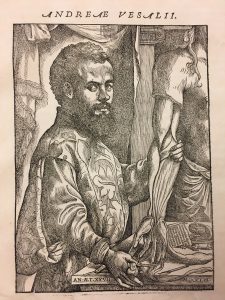The only authentic portrait of Andreas Vesalius is this famous woodcut from the Fabrica, first introduced in 1543. The same wood block was used in the later edition of 1555, as well as in both Latin and German editions of his Epitome.

Portrait of Andreas Vesalius. De humani corporis fabrica, 1543 (UBC Rare Books and Special Collections)
On the front edge of the table is the following inscription: AN. AET. XXVIII. M.D.XLII. This apparently provides us with the date of the portrait as well as the age of Vesalius at the time of illustration (Saunders and O’Malley 41).
Just beneath those dates, still on the table, is the following message: OCYUS, IUNCUNDE ET TUTO, meaning “swiftly, pleasantly and safely.” This message is apparently derived from a proverb of the ancient physician Aesclepiades, quoting from a medieval version of the works of Aulus Cornelius Celsus (25 BC – 50 AD), which reads, “Aesclepiades says that it is the duty of the physician to cure his patient safely, swiftly and pleasantly” (Saunders and O’Malley 41).
The portrait has some wonky features. Firstly, the head of Vesalius is disproportionately large for his body. His disproportions become more obvious when we take into consideration the body he’s dissecting. It’s huge! Whether the disproportions were made purposefully (maybe he really looked like that?), or accidentally (probably more likely), it’s pretty fun to have an anatomically incorrect author on a revolutionary book about anatomy.
Disproportions notwithstanding, the portrait is universally admired for its beauty. It expresses a wise, energetic young man carrying himself with much self assurance. It’s impossible to deny the admirable skill behind the woodcut.
The artist is unknown. Most critics assert that it is the work of Flemish artist Jan Stefan van Kalkar, yet still others entertain the idea that it is self-portrait, seeing as the pose is characteristic of a drawing made from a mirror image (Saunders and O’Malley 41).
